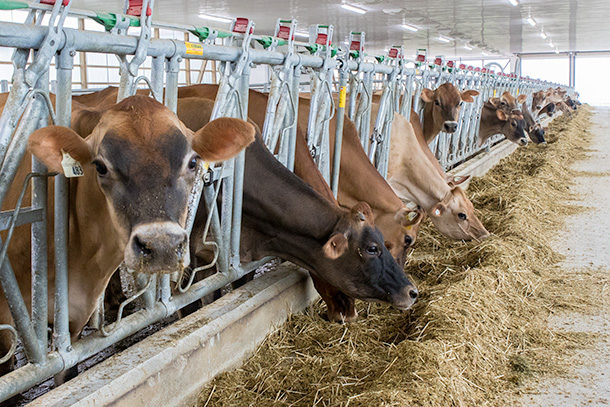As dairy cows produce higher and higher volumes of milk, the need for a higher caloric intake is necessary to help support this huge demand for energy. Dairy cow diets typically contain some form of fat, either from rumen-active sources such as cottonseed, distillers, tallow and roasted beans or from rumen-inert fats such as calcium salts or prilled fats.
Research has reported improvements in milk yield and milkfat yield when cows are supplemented with fat. However, we need to start evaluating fat supplementation by looking at the individual fatty acid (FA) levels fed, much like we analyze amino acids for proteins. Palmitic (C16), stearic (C18) and oleic (C18:1) are the major fatty acids in milk. There has been a wide range in responses and roles of each individual fatty acid regarding performance. Fatty acids in general have shown to increase milk, increase milk components and decrease dry matter intake (DMI), but again, the response has been variable. Palmitic will favor partitioning to milkfat and energy-corrected milk, while stearic has shown to increase milk yield and components in high-yielding cows. While stearic is generally lower inclusion in the diet, it is the byproduct of biohydrogenation of unsaturated fatty acids in the rumen, which makes it plentiful in the small intestine. Meanwhile, oleic has been shown to increase fatty-acid digestibility in the small intestine, as well as to improve body condition. The bottom line is that palmitic, stearic and oleic are fatty acids we need to support energy in the dairy cow.
Energy balance and embryo quality
Even when we include these energy-dense sources in the diet, cows in early lactation mobilize body fat to help meet the caloric deficit between calories needed to support milk production and calories consumed (Figure 1). When cows mobilize body fat, one by-product is non-esterified fatty acids (NEFAs).

Several studies have reported the negative impact high NEFAs have on oocyte and embryo quality. In vitro studies have reported that elevated NEFAs have resulted in lower development of fertilized ooctyes day one to day seven, lower embryo development at day 14 and have hampered embyro implantation and development.
Carvalho et al. ranked 71 cows into four quartiles based on percent of bodyweight change from week one to week nine following parturition. First-quartile cows gained weight, second-quartile cows showed no change, third-quartile cows recorded mild weight loss and fourth-quartile cows lost excessive bodyweight. Cows were superovulated using a modified Double Ovsynch protocol to evaluate oocyte and embryo quality. The author reported no difference in the number of ovulations, total embryos collected or the perecntage of eggs fertilized. Even though there was no impact on egg fertization, excessive bodyweight loss (fourth-quartile) negatively impacted embryo development at day seven (Table 1).

The number of transferable embryos in cows with excessive bodyweight (fourth-quartile) loss was significanty lower than for the other three quartiles. In addition, the percentage of degenerate embryos was higher in the excessive bodyweight-loss group (Table 1). This study clearly demonstrates the negative impact body condition loss and high NEFAs have on embryo development.
Negative effects from inflammation
Another contributing factor to fat mobilization is inflammation. Dr. Contreras from Michigan State University stated that all cows will experience several inflammatory events over the course of their lactation, such as calving, expulsion of the placenta, diet changes, pen moves, etc. Cows that transition well do not experience extreme inflammation, thus they will maintain or increase DMI and avoid metabolic issues or milk loss. However, in unsuccessful transitions where a cow experiences severe and chronic inflammation, glucose is now spared away from milk to support the overtaxed immune system. This leads to a decrease in DMI, resulting in more adipose tissue being mobilized and higher NEFA levels.
High-producing cows will always lose some body condition in early lactation and will show high NEFA levels. We have made great strides in nutrition, facilities and grouping strategies to help minimize the degree of weight loss during the transition period, reducing the incidence of metabolic disorders and infertility. However, are there other areas that dairy producers should consider that may help improve immune health and reproductive function, or specifically, fertilized oocyte development and embryo implantation?
EPA/DHA omega-3 effects on fertility
There is another category of fatty acids that need consideration: biologically active fatty acids called omega-3s. These fatty acids are not used as an energy source but rather support specific biological functions, such as immunity and reproduction. Omega-3s are stored in the cell membrane and are highly concentrated in lipid droplets surrounding growing embryos, reflecting the priority EPA/DHA has for reproduction and immune function rather than being utilized as an energy source.
Feeding EPA/DHA omega-3s has been shown to significantly improve conception rates and to lower the incidence of early abortions from day 32 to 60 post-breeding. But what impact does EPA/DHA have on those first few days of oocyte development and during embryo implantation? More recent work by Oseikria et al. reported significant improvements in oocyte development at day seven – blastocyst stage – when the fertilized oocyte was exposed to a very small amount of DHA (Figure 2). The number of cells per blastocyst were also higher when exposed to DHA, thus demonstrating a beneficial impact of low levels of EPA/DHA on oocyte development.

Embryo elongation, implantation and pregnancy rate
Another benefit of feeding omega-3s is embryo elongation and implantation. Mattos et al. looked at the suppresson of prostaglandin F2a (PGF2a) when endometrial cells were exposed to EPA and interferon tau (IFN-t). IFN-t is commonly called the pregnancy hormone, and the larger the embryo, the more IFN-t is secreted, which signals a reduction in PGF2a to maintain pregnancy. In this study, the researchers looked at two levels of EPA and two levels of IFN-t against a zero control. Both levels of EPA omega-3 significantly lowered PGF2a by 40% compared to the control without any IFN-t, demonstrating the direct effect EPA has on improving pregnancy maintenance. The combination of IFN-t and EPA at the highest inclusion level reduced PFG2a by approximaltey 75% compared to the control, suggesting a strong synergistic effect.
In a study by Sinedino et al., they fed 100 grams of algae containing 10% DHA to early lactation cows to evaluate the impact on days to pregnancy and percent of cows not pregnant (Figure 3). The percent of cows not pregnant on days 90 to 160 was approximately 10% lower in cows being fed DHA. Researchers found that cows on the DHA omega-3 treatment were pregnant 21 days sooner than control cows.

Not just energy
In summary, minimizing body condition loss and corresponding NEFA levels during the transition period will no doubt help set your cows up to become pregnant faster. However, energy balance is only part of the fatty acids and pregnancy equation. The role that bioactive omega-3 fatty acids play is beyond energy.
In particular, EPA/DHA are essential nutrients that are part of how her biology is meant to function, supporting a healthy immune response and helping her efficiently achieve and maintain pregnancy. EPA/DHA are the source of specialized immune molecules that prevent her immune system from over-responding and assist in rapidly resolving inflammation after an insult, thus sparing glucose that is needed in early lactation to prevent excess body condition loss. Providing base levels of EPA/DHA omega-3s in dairy cow diets will assist in proper oocyte and embryo development and will improve embryo implantation rate and lower pregnancy losses.
References omitted but are available upon request by sending an email to the editor.






